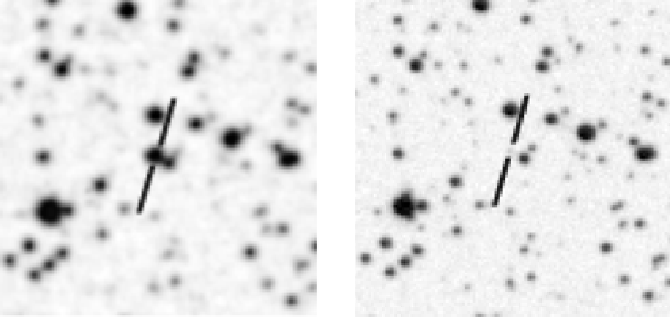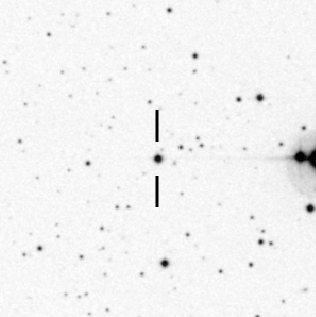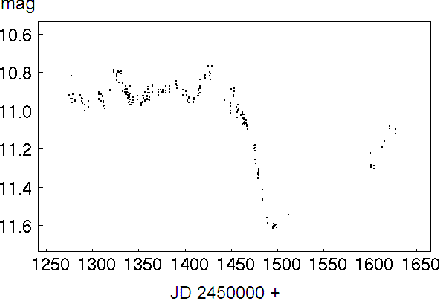|
Peremennye Zvezdy (Variable Stars) 36, No. 2, 2016 Received 11 November; accepted 20 December.
|
Article in PDF |
Cataclysmic and RCB Type Candidates for Identification of Three Suspected Variables
E. V. Kazarovets
Institute of Astronomy, Russian Academy of Sciences,
Pyatnitskaya Str. 48, 119017, Russia; e-mail:
helene@inasan.ru
| I report the discovery of two cataclismic variable stars as probable candidates for identification of the Luyten's variable HV 9251 (NSV 10231) and Wolfs' object AN 115.1905 (NSV 12542). I also suggest the possible RCB variability type for Hoffmeister's star S 9384 (NSV 11988). |
1. Introduction
This paper deals with three stars from the NSV catalog: NSV 10231, NSV 11988, and NSV 12542. The first of them, without a published finding chart and with rough coordinates only, was virtually lost for decades. The second one, though easier to identify, remained poorly studied. The third star could be selected from three stars, close to each other, in the position marked on the finding chart.
In the course of my systematic work on identification of NSV stars, I have been able to find that these three stars probably belong to comparatively rare and rather interesting types of stellar variability.
2. NSV 10231 and NSV 12542
The first variable, HV 9251 = NSV 10231, was reported by Luyten
(1935). Its photographic variability range was announced as 17.0
- ![]() . A finding chart was never published, and, the
coordinates provided by Luyten being only rough, its actual
location remained unknown. The discoverer presented no information
on the star's variability type.
. A finding chart was never published, and, the
coordinates provided by Luyten being only rough, its actual
location remained unknown. The discoverer presented no information
on the star's variability type.
In the course of our work on new electronic version of the NSV
catalog (Kholopov et al. 1982), I determine, in particular,
accurate positions of the stars and aspire to recover all
suspected variables lacking published finding charts. Looking for
an identification candidate for the Luyten's variable HV 9251, I
noticed the star USNO-A2.0 0375-34430892 = USNO-B1.0 0430-0752563
= GSC 2.3 SA03005977 (18![]() 08
08![]() 41
41![]() 419,
-46
419,
-46![]() 54
54![]() 47
47
![]() 79, J2000, epoch 1992.555, from the GSC 2.3
catalog) showing strong variability between the red DSS images of
two different epochs.
79, J2000, epoch 1992.555, from the GSC 2.3
catalog) showing strong variability between the red DSS images of
two different epochs.
The variable was at its high stage (![]() ) on the 1985 July
15 plate (ESO.R-MAMA) and at its low stage (
) on the 1985 July
15 plate (ESO.R-MAMA) and at its low stage (![]() ), on the
1992 July 22 plate (AAO.R-DSS2) from the Aladin Sky Atlas. The
), on the
1992 July 22 plate (AAO.R-DSS2) from the Aladin Sky Atlas. The ![]() magnitudes were estimated using red magnitudes of comparison stars
from the A2.0 catalog. The star is also at its quiescence level on
several DSS plates in different bands (two
magnitudes were estimated using red magnitudes of comparison stars
from the A2.0 catalog. The star is also at its quiescence level on
several DSS plates in different bands (two ![]() , three
, three ![]() , and two
infrared plates) from the STScI Archive. The corresponding epochs
are: 1987 September 13 and 17 (
, and two
infrared plates) from the STScI Archive. The corresponding epochs
are: 1987 September 13 and 17 (![]() ); 1993 April 18, 1996
August 24, and 1998 July 16 (
); 1993 April 18, 1996
August 24, and 1998 July 16 (![]() ); 1981 April 26 and 1987 July 4
(IR). The
); 1981 April 26 and 1987 July 4
(IR). The ![]() fragments of the 1985 and 1992 red plates
are shown in Fig. 1.
fragments of the 1985 and 1992 red plates
are shown in Fig. 1.
Individual magnitudes from catalogs are the following. USNO-A2.0:
![]() ,
, ![]() ; USNO-B1.0:
; USNO-B1.0: ![]() ,
, ![]() ,
, ![]() ,
, ![]() ; GSC 2.3:
; GSC 2.3: ![]() ,
, ![]() ,
, ![]() ,
, ![]() . The epoch of the USNO-A2.0 red plate is
1980.075, but, unfortunately, we could not find access to the
epochs of USNO-B1.0 and GSC 2.3 observations. It is possible to
suppose that another outburst was detected at the USNO-A2.0 epoch,
and maybe also at least at one of the unknown USNO-B1.0 and GSC
2.3 plate epochs. (The epoch of the star's coordinates given in
the GSC 2.3 catalog is 1992.555, coinciding with that of the red
plate in the right panel of Fig. 1, where the star is faint; the
mean epoch of observation quoted in the USNO-B1.0 catalog, 1985.0,
does not coincide exactly with those for any of the plates listed
above.)
. The epoch of the USNO-A2.0 red plate is
1980.075, but, unfortunately, we could not find access to the
epochs of USNO-B1.0 and GSC 2.3 observations. It is possible to
suppose that another outburst was detected at the USNO-A2.0 epoch,
and maybe also at least at one of the unknown USNO-B1.0 and GSC
2.3 plate epochs. (The epoch of the star's coordinates given in
the GSC 2.3 catalog is 1992.555, coinciding with that of the red
plate in the right panel of Fig. 1, where the star is faint; the
mean epoch of observation quoted in the USNO-B1.0 catalog, 1985.0,
does not coincide exactly with those for any of the plates listed
above.)
 |
Fig. 1.
USNO-A2.0 0375-34430892 on the red DSS
plates. Left: 1985 July 15; right: 1992 July 22. The field is |
The star is not contained in the 2MASS catalog, thus it is not
strongly colored. Its very low brightness on two DSS IR plates
seems to rule out the possibility of its being a red flare star.
Use of publicly available electronic archive of CCD observations
of the Catalina Sky Survey (Drake et al. 2009) for our southern
star was excluded, there being no data in the Milky Way zone. The
star is too faint (![]() ) for CCD observations of the ASAS-3
project (Pojmanski 2002). The object does not enter the
photometric and spectroscopic catalog of the Sloan Digital Sky
Survey III (Ahn et al. 2012). Also, the field is not in any X-ray
catalogs.
) for CCD observations of the ASAS-3
project (Pojmanski 2002). The object does not enter the
photometric and spectroscopic catalog of the Sloan Digital Sky
Survey III (Ahn et al. 2012). Also, the field is not in any X-ray
catalogs.
However, our variable is the UV source GALEX J180841.4-465447 (nuv = 18.14). Therefore I believe that the object in question is a cataclysmic variable, likely a dwarf nova of the UG type.
Returning to the identification problem for the Luyten's variable,
the cataclismic variable is 1![]() 4 to N-NW from the position
published by Luyten. This is a usual error for Luyten's
measurements of coordinates for his stars, as it follows from our
many-year experience of searching for his variables. The
photographic brightness and variability range for HV 9251 (see
above) are in a very good agreement with the range of variability
and brightness we find for our probable cataclysmic star. I find
no other variable stars in the
4 to N-NW from the position
published by Luyten. This is a usual error for Luyten's
measurements of coordinates for his stars, as it follows from our
many-year experience of searching for his variables. The
photographic brightness and variability range for HV 9251 (see
above) are in a very good agreement with the range of variability
and brightness we find for our probable cataclysmic star. I find
no other variable stars in the ![]() field around
Luyten's position. Based on these findings, I suggest to consider
that USNO-A2.0 0375-34430892 and HV 9251 are the same object.
field around
Luyten's position. Based on these findings, I suggest to consider
that USNO-A2.0 0375-34430892 and HV 9251 are the same object.
The second candidate cataclysmic variable, NSV 12542, featured a
stronger outburst than the first one. I discovered it and
identified with USNO-A2.0 0975-17056159 = USNO-B1.0 0989-00509811,
with the coordinates 19![]() 54
54![]() 33
33![]() 035,
+08
035,
+08![]() 54
54![]() 17
17
![]() 44 (J2000, epoch 1971.5) from the USNO-B1.0
catalog. I believe that this is the star whose outburst was
discovered by Wolf & Wolf (1905). They reported the star AN
115.1905 to be bright on a single plate (1905 September 18), while
it was invisible on three other plates taken in 1901, 1903, 1904.
A finding chart was published. In the NSV catalog, the star is
numbered NSV 12542; its variability range is given as
44 (J2000, epoch 1971.5) from the USNO-B1.0
catalog. I believe that this is the star whose outburst was
discovered by Wolf & Wolf (1905). They reported the star AN
115.1905 to be bright on a single plate (1905 September 18), while
it was invisible on three other plates taken in 1901, 1903, 1904.
A finding chart was published. In the NSV catalog, the star is
numbered NSV 12542; its variability range is given as ![]() pg.
pg.
When identifying the variable discovered by Wolfs using their
finding chart, I found that the circle on the finding chart that
marks the variable covers three faint stars; they form a triangle
with ![]() sides. It seemed improbable to positively identify
the variable with one of the three candidates.
sides. It seemed improbable to positively identify
the variable with one of the three candidates.
Like in the previous case, I compared images from the Aladin Sky
Atlas: fragments of the POSS I plates (red and blue, 1950 July 11)
and of the POSS II plates (red, 1991 July 17, and blue, 1990 July
27). The faintest star of the triangle was found unusually bright
on the two POSS I plates from the same night. Its brightness
estimates made with similar use of comparison stars are:
![]() (POSS II, J),
(POSS II, J), ![]() (POSS I, O),
(POSS I, O), ![]() (POSS II, F),
(POSS II, F), ![]() (POSS I, E). The object is faint in
quiescence and located in the Milky Way band, and thus, for one or
both of these reasons, is not contained in the 2MASS, GSC 2.3,
GALEX, SDSS, X-ray catalogs or in the ASAS-3, Catalina sky
surveys. Individual estimates, without clearly indicated
observation epochs, can be found in the USNO-B1.0 catalog:
(POSS I, E). The object is faint in
quiescence and located in the Milky Way band, and thus, for one or
both of these reasons, is not contained in the 2MASS, GSC 2.3,
GALEX, SDSS, X-ray catalogs or in the ASAS-3, Catalina sky
surveys. Individual estimates, without clearly indicated
observation epochs, can be found in the USNO-B1.0 catalog:
![]() ,
, ![]() ,
, ![]() ,
, ![]() . The brightness
estimates from the USNO-A2.0 catalog (
. The brightness
estimates from the USNO-A2.0 catalog (![]() ,
, ![]() ) are
based on the POSS I plates (1950) and have the same epoch as our
POSS I estimates. However, moderate angular resolution results in
noticeable influence from nearby faint neighbor stars in A2.0
magnitudes. We can assume that the bright USNO-B1.0 B-band
estimate is based on the first Palomar survey.
) are
based on the POSS I plates (1950) and have the same epoch as our
POSS I estimates. However, moderate angular resolution results in
noticeable influence from nearby faint neighbor stars in A2.0
magnitudes. We can assume that the bright USNO-B1.0 B-band
estimate is based on the first Palomar survey.
Figure 2 displays ![]() fragments of the 1950 and 1990 blue
plates.
fragments of the 1950 and 1990 blue
plates.
 |
Fig. 2.
USNO-A2.0 0975-17056159 on the blue DSS
plates. Left: 1950 July 11; right: 1990 July 27. The field is
|
The STScI archive contains, besides the four above-mentioned
images of the sky region in question, two more blue (1953
September 5 and 1990 August 13), two ![]() -band (both taken on 1982
June 24), two
-band (both taken on 1982
June 24), two ![]() -band (1953 September 5 and 1991 July 13), and
two infrared (1994 June 3 and 1995 July 22) plates. The star's
brightness is at the minimum level on all of them. Thus, judging
from brightness estimates at maximum (from the same observing
night!), we can assume that the star is not strongly colored and
maybe even bluish. Two outbursts by
-band (1953 September 5 and 1991 July 13), and
two infrared (1994 June 3 and 1995 July 22) plates. The star's
brightness is at the minimum level on all of them. Thus, judging
from brightness estimates at maximum (from the same observing
night!), we can assume that the star is not strongly colored and
maybe even bluish. Two outbursts by
![]() recorded, presumably
for the same object, in half a century suggest that, by its
nature, the star is a cataclysmic, UG-type variable.
recorded, presumably
for the same object, in half a century suggest that, by its
nature, the star is a cataclysmic, UG-type variable.
3. NSV 11988
The third variable, S 9384 = NSV 11988, was announced by Hoffmeister (1966), who also published a finding chart. According to him, the star slowly varies between 13.5 and 14 (pg) and is moderately red.
I identify this variable with the star GSC 03929-01166 (12.3) =
IRAS F19222+5655. The coordinates from the 2MASS catalog are
19![]() 23
23![]() 13
13![]() 104, +57
104, +57![]() 00
00![]() 55
55
![]() 58 (J2000, epoch
2000.340), and the magnitudes
58 (J2000, epoch
2000.340), and the magnitudes ![]() ,
, ![]() ,
, ![]() suggest an infrared excess.
suggest an infrared excess.
A ![]() finding chart for this variable is shown in Fig. 3.
finding chart for this variable is shown in Fig. 3.
 |
Fig. 3.
The finding chart of NSV 11988 from a blue
STScI DSS Archive image. The field is |
The authors of the ROTSE1/NSVS project (Wozniak et al. 2004)
suggest the variability type L: and period of 374![]() for this
variable. The light curve of the star, based on the observations
of the NSVS object ID 3070388, is shown in Fig. 4. These
unfiltered broad-band (450-1000 nm) CCD observations (called
for this
variable. The light curve of the star, based on the observations
of the NSVS object ID 3070388, is shown in Fig. 4. These
unfiltered broad-band (450-1000 nm) CCD observations (called
![]() ) cover the time range between JD 2451274 and 2451633. The
light curve shows variations between 10.8 and 11.6 (
) cover the time range between JD 2451274 and 2451633. The
light curve shows variations between 10.8 and 11.6 (![]() ). At
maximum, the star is 10.8-11.0 (
). At
maximum, the star is 10.8-11.0 (![]() ). A single deep minimum
began after JD 2451452 and reached the bottom in 40 days. Then, we
see a gradual brightness increase, nearly to the maximum at the
end of the observational interval. Oscillations with a small
amplitude were observed outside this minimum, the cycle being
about 59
). A single deep minimum
began after JD 2451452 and reached the bottom in 40 days. Then, we
see a gradual brightness increase, nearly to the maximum at the
end of the observational interval. Oscillations with a small
amplitude were observed outside this minimum, the cycle being
about 59![]() 0. I am not aware of any publications concerning the
spectral type of NSV 11988; however, the photometric data suggest
that it is a quite typical RCB variable. Spectroscopy of the star
is urgently needed.
0. I am not aware of any publications concerning the
spectral type of NSV 11988; however, the photometric data suggest
that it is a quite typical RCB variable. Spectroscopy of the star
is urgently needed.
Acknowledgments: Thanks are due to Dr. N.N. Samus for his
assistance and to Dr. V.P. Goranskii for providing his
period-search software. Our studies are supported in part by a
grant from the program "Origin and Evolution of Stars and
Galaxies" of the Presidium of Russian Academy of Sciences.
References:
Ahn, C.P., Alexandroff, R., Allende Prieto, C., et al., 2012, Astrophys. J. Suppl. Ser., 203, 21
Drake, A.J., Djorgovski, S.G., Mahabal, A., et al., 2009, Astrophys. J., 696, 870
Hoffmeister, C., 1966, Astron. Nachr., 289, 139
Kholopov, P.N. (editor), 1982, New Catalogue of Suspected Variable Stars, Moscow: "Nauka"
Luyten, W.J., 1935, Astron. Nachr., 258, 121
Pojmanski, G., 2002, Acta Astron., 52, 397
Wolf, M., Wolf, G., 1905, Astron. Nachr., 169, 407
Wozniak, P.R., Westrand, W.T., Akerlof, C.W., et al., 2004, Astron. J., 127, 2436
